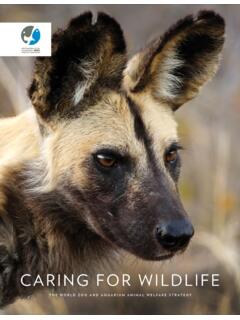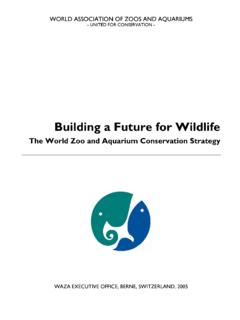Transcription of WAZA CODE OF ETHICS AND ANIMAL WELFARE
1 waza code OF ETHICS AND ANIMAL WELFARE (Adopted November 2003, San Jos , Costa Rica) Preamble The continued existence of zoological parks and aquariums depends upon recognition that our profession is based on respect for the dignity of the animals in our care, the people we serve and other members of the international zoo profession. Acceptance of the waza World Zoo Conservation Strategy is implicit in involvement in the waza . Whilst recognising that each region may have formulated its own code of ETHICS , and a code of ANIMAL WELFARE , the waza will strive to develop an ethical tradition which is strong and which will form the basis of a standard of conduct for our profession.
2 Members will deal with each other to the highest standard of ethical conduct. Basic principles for the guidance of all members of the World Association of Zoos and Aquariums: (i) Assisting in achieving the conservation and survival of species must be the aim of all members of the profession. Any actions taken in relation to an individual ANIMAL , euthanasia or contraception, must be undertaken with this higher ideal of species survival in mind, but the WELFARE of the individual ANIMAL should not be compromised. (ii) Promote the interests of wildlife conservation, biodiversity and ANIMAL WELFARE to colleagues and to society at large.
3 (iii) Co-operate with the wider conservation community including wildlife agencies, conservation organisations and research institutions to assist in maintaining global biodiversity. (iv) Co-operate with governments and other appropriate bodies to improve standards of ANIMAL WELFARE and ensure the WELFARE of all animals in our care. (v) Encourage research and dissemination of achievements and results in appropriate publications and forums. (vi) Deal fairly with members in the dissemination of professional information and advice. (vii) Promote public education programmes and cultural recreational activities of zoos and aquariums.
4 (viii) Work progressively towards achieving all professional guidelines established by the waza . At all times members will act in accordance with all local, national and international law and will strive for the highest standards of operation in all areas including the following: 1. ANIMAL WELFARE Whilst recognising the variation in culture and customs within which the waza operates, it is incumbent upon all members to exercise the highest standards of ANIMAL WELFARE and to encourage these standards in others. Training staff to the highest level possible represents one method of ensuring this aim.
5 Members of waza will ensure that all animals in their care are treated with the utmost care and their WELFARE should be paramount all times. At all times, any legislated codes for ANIMAL WELFARE should be regarded as minimum standards. Appropriate ANIMAL husbandry practices must be in place and sound veterinary care available. When an ANIMAL has no reasonable quality of life, it should be euthanased quickly and without suffering. 2. Use of Zoo and Aquarium Based Animals Where "wild" animals are used in presentations, these presentations must:- (a) deliver a sound conservation message, or be of other educational value, (b) focus on natural behaviour, (c) not demean or trivialise the ANIMAL in any way.
6 If there is any indication that the WELFARE of the ANIMAL is being compromised, the presentation should be brought to a conclusion. When not being used for presentations, the "off-limit" areas must allow the ANIMAL sufficient space to express natural behaviour and should contain adequate items for behavioural enrichment. While the code focuses on zoos and aquarium based "wild" animals, the WELFARE of domestic animals, , sheep, goats, horses, etc., in, , petting zoos should not be compromised. 3. Exhibit Standards All exhibits must be of such size and volume as to allow the ANIMAL to express its natural behaviours.
7 Enclosures must contain sufficient material to allow behavioural enrichment and allow the ANIMAL to express natural behaviours. The animals should have areas to which they may retreat and separate facilities should be available to allow separation of animals where necessary, , cubbing dens. At all times animals should be protected from conditions detrimental to their well-being and the appropriate husbandry standards adhered to. 4. Acquisition of Animals All members will endeavour to ensure that the source of animals is confined to those born in human care and this will be best achieved by direct zoo to zoo conduct.
8 The advice of the appropriate Species Co-ordinator should be sought before acquiring animals. This will not preclude the receipt of animals resulting from confiscation or rescues. It is recognised that, from time to time, there is a legitimate need for conservation breeding programmes, education programmes or basic biological studies, to obtain animals from the wild. Members must be confident that such acquisitions will not have a deleterious effect upon the wild population. 5. Transfer of Animals Members will ensure institutions receiving animals have appropriate facilities to hold the animals and skilled staff who are capable of maintaining the same high standard of husbandry and WELFARE as required of waza members.
9 All animals being transferred will be accompanied by appropriate records with details of health, diet, reproductive and genetic status and behavioural characteristics having been disclosed at the commencement of negotiations. These records will allow the receiving institution to make appropriate decisions regarding the future management of the ANIMAL . All ANIMAL transfers should conform to the international standards and laws applying to the particular species. Where appropriate, animals should be accompanied by qualified staff. 6. Contraception Contraception may be used wherever there is a need for reasons of population management.
10 The possible side effects of both surgical and chemical contraception, as well as the negative impact on behaviour, should be considered before the final decision to implement contraception is made. 7. Euthanasia When all options have been investigated and the decision is taken that it is necessary to euthanise an ANIMAL , care will be taken to ensure it is carried out in a manner that ensures a quick death without suffering. Euthanasia may be controlled by local customs and laws but should always be used in preference to keeping an ANIMAL alive under conditions which do not allow it to experience an appropriate quality of life.




